ImagineMe Mannequin Contest 2011
Created in 2010, this mannequin art competition is designed to promote healthy awareness and acceptance of body image. iaedp invites national art therapists from treatment centers and private practice, students and the public to artistically create mannequins that reflect their perception of beauty and body image.
Judging Criteria
Mannequin entries are judged on clarity of theme, creativity and originality, quality of composition and design, and the overall impression and presentation of the artwork. The contest is open to everyone; however, iaedp encourages treatment centers and private practices with art therapists to work with patients to provide entries.
Each year, poster images of the mannequin entries are displayed gallery-style at iaedp’s Annual Symposium. The Winner, Runner-Up, Honorable Mention and Professional’s Choice are awarded during a special ceremony. The winner receives a financial award along with the image of their mannequin being used in Imagine Me Beyond What You See™ promotions throughout the coming year. For the awards ceremony, the winning mannequin is shipped to the Annual Symposium, unveiled along with the artist(s) and later auctioned off with proceeds to benefit the iaedp Foundation.
Video Review
Winner: Erosion

Artist: Rebecca Tishman
I have heard “it’s not about the food” a countless number of times at this point in my recovery. There is so much beyond the food, but for years I refused to acknowledge the pain that I masked by not eating or by purging. In an attempt to show that to the world through my art, I made the outside layer of the female form out of silverware which simultaneously hides the female form beneath it, and draws attention to the outward appearance of the female.
Artist Profile:
I am an interdisciplinary sculpture major at the Maryland Institute College of Art. It was not until I started focusing on the link between my recovery from an eating disorder and my artwork that I started to flourish in both fields. Embracing the symbiotic relationship between the two has been an interesting and bumpy road for me to venture down.
Balance
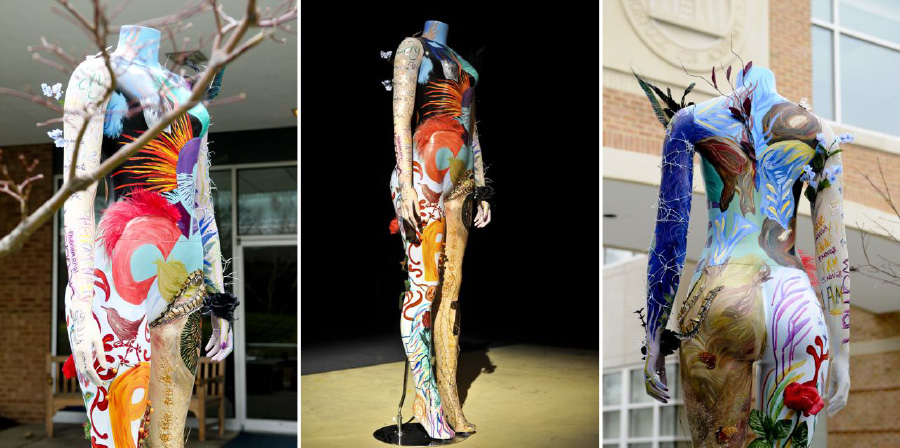
Artist: Sophie Wolfe
My goal was to create a balance between love and appreciation for the body as well as acceptance of all emotions (good and bad) towards the body. On the front, the letters A-C-C-E-P-T are incorporated into the design. On the back the letters L-O-V-E surround the butterfly.
Artist Profile:
I am a senior in high school in Virginia Beach and planning to attend Tufts University next fall.
Since I finished my second course of treatment at the Eating Recovery Center last August, I have spent countless hours working on this piece and it has been a wonderful part of my recovery.
Hear Me, Please
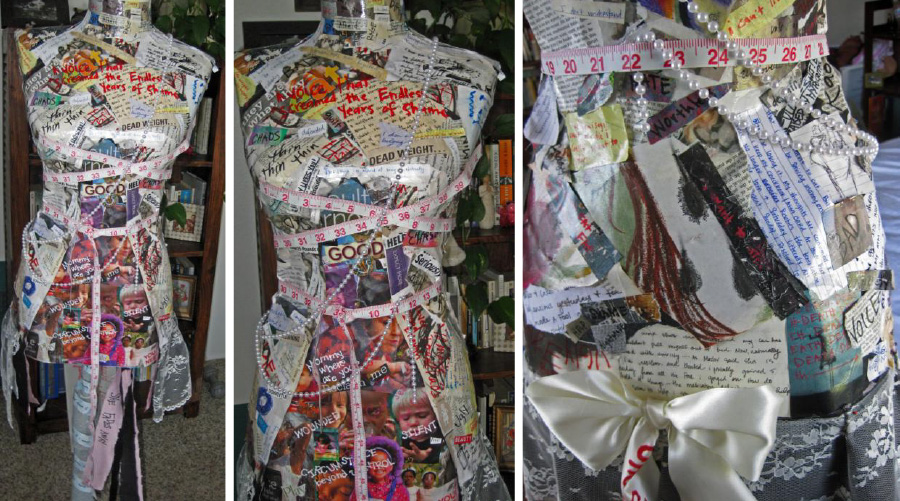
Artist: Sara Burchfiel
The mannequin I created is primarily made up of torn out journal pages from years stolen by my eating disorder. The inner layers are cutouts of children (a photo of me as a child is there as well) – originally, I wanted it to depict my inner child beneath all the self-abuse that was aching to be set free, but as I began to collage the pieces on, I realized that it also needed to represent the little girl that was wounded and hurt. I added pearls, a lace skirt, and ribbon as symbolic of trying to hide the deep pain and shame of an eating disorder.
Artist Profile:
I was in treatment from intensive treatment from 2006-2008 at Shoreline Center in Long Beach, CA.
I continue to see my therapist weekly. I would have never imagined the healing that I have come to experience. My recovery has been a grueling journey, but worth every single step. I am grateful for my health. For peace. And laughter.
Scapegoat Beauty
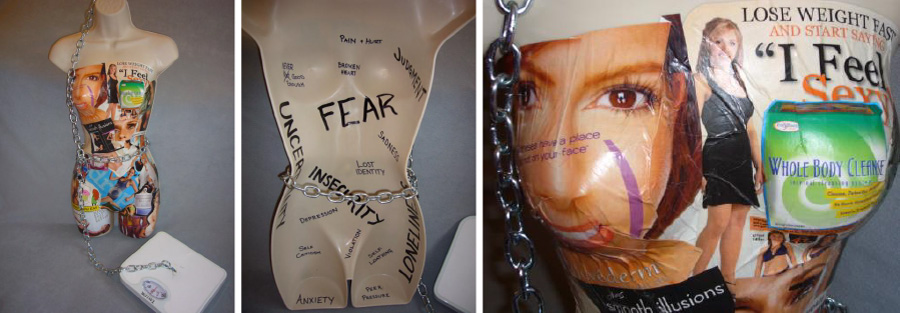
Artist: Hallie Espel
My artwork is a representation of the female struggle with body image and self-acceptance. My journey through illness and recovery from my eating disorder has led me to question the ways in which we are taught to alter our bodies. We use make up, accessories, and even such extremes as diet pills and cleanses, anti-wrinkle formulas, etc. We are bombarded with images of the “ideal” body and ways to “achieve” it from an early age, and we are rarely taught to appreciate our bodies for what they do for us. The body often becomes a scapegoat for underlying emotional issues. The outside of my mannequin is covered with images from popular magazines- images that encourage women to alter their bodies. On the inside, I wrote different underlying issues that these “alterations” perhaps might be covering up.
As for a description of the last image I sent in, that is the back side of the mannequin that I used. It is concave, so that’s why it might be hard to see in a 1-D image. I chose the following words: (Fear, Insecurity, Violation, Judgment, Never Good Enough, Uncertainty, Broken Heart, Peer Pressure, Anxiety, etc.), which I believe are common issues for women with eating disorders (like myself and others I have met in treatment). I feel that the body becomes the “scapegoat” target through dieting, restriction, binge/purge, etc. for these issues. In my own illness, I sought to eliminate emotional pain and discomfort using my appetite and my body as a scapegoat for what was really going on underneath. In addition, I believe our culture also feeds into this assumption that altering the external body will lead to internal happiness or success in life, which is why I think the media images on the mannequin relate to the words on the inside.
Artist Profile:
I am a 23-year-old woman in recovery from an eating disorder after struggling for 10 years. Before recovery, I thought that my eating disorder would be a reality for the rest of my life. Now I live life of fullness, authenticity, and peace of mind that I didn’t know was possible for anyone, let alone myself. I created this mannequin artwork last summer, shortly after being discharged from a transformative residential treatment stay. My therapist later suggested I submit it to the competition; I was unaware that the art competition existed when I made it. The art served as an outlet for my frustration at how our culture teaches us that our bodies are the thing that is “wrong” with us. The message is that if we perfect our bodies, we will find happiness. My recovery has been about building a relationship with my body. I listen to it, give it what it needs, and send it gratitude for serving me. What matters is not my body’s appearance, but how it feels and how it helps me live my life.
In Full Bloom

Artist: Magnolia Creek Treatment Center for Eating Disorders Residents, Spring Olsen, Art Therapist with Casey Palmer, Staff Counselor
The front of the Mannequin shows flowers in full bloom representing full potential and the beauty of recovery. This is in contrast to the back where there are buds, waiting to bloom but needing nourishment. Each side transitions from the buds to the blossoms.
Artist Profile:
In art group, themes were discussed. In discussion, the desire to someday reach full potential and to recover was expressed. One RT volunteered to do the painting and the group agreed. Her treatment ended before the mannequin could be completed. A second RT stepped in and finished the art work. As the artists worked, the group made suggestions and shared their ideas.
I am a Soul with a Body
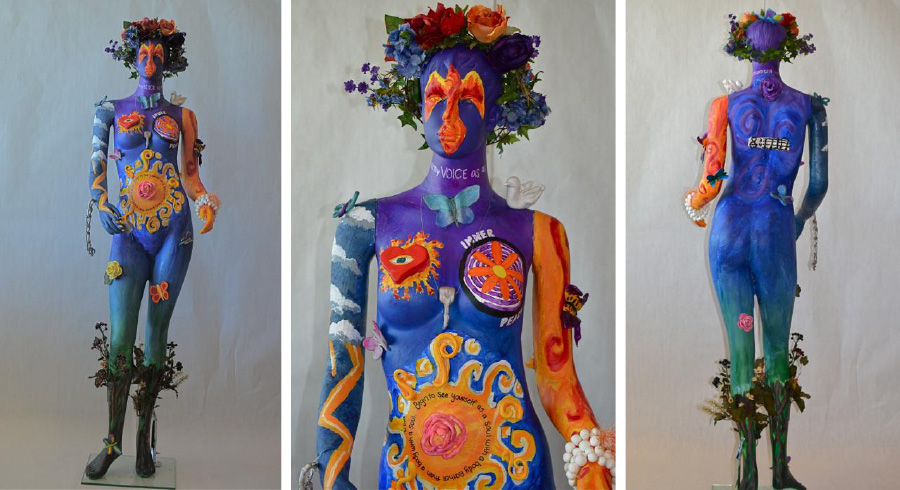
Artist: Lisa Talucci, Art Therapist
Eating Recovery Center’s Partial Hospital Program spent a span of 4 months working on the body image project Imagine Me Beyond What You See . It was introduced to Eating Recovery Center’s Partial Hospital Program as a way to work on body image issues through constructing a 3 dimensional artwork using a mannequin. Each time the group was offered, PHP clients elected to work on the project. Every group had a different constellation of participants. At each group, we checked in, reviewed the project, generated ideas, images and symbols of recovery and what it meant to each person to see beyond their physical appearance. The project evolved through each individual voicing what they envisioned and then the group collectively made creative decisions that reflected aspects of their healing. Each group ended with a closing that allowed participants to voice the emotional process and the creative process during group time. It provided an empowering vehicle for people to work on a community artwork as well as a public artwork that invited each person to be seen and heard.
The project began with a group encountering the mannequin whose form appeared all too thin. So, the first 4-5 hours were spent weight restoring the form using layers of tissue paper and glue applied to the collar bones, waist and legs. This process mirrored the time and patience that it takes to restore ones own mind and body. The group generated a list of ideas, symbols and thoughts of the inner self and who we are internally, beyond our physical form. Each time the group met, an evolving constellation of people worked on the symbols and moved the creative process to the next step. At the center of the form reads “Begin to see yourself as a soul with a body rather than a body with a soul.(-Wayne Dyer).
There are multiple symbolisms in our piece. On the face is the phoenix, rising from the ashes, empowered. The head wreath symbolizes growth and wholeness. Her right arm is a thunderstorm that she has endured. On her right wrist is a chain that she has freed herself from and she is holding an open lock. The right arm is a warm, life affirming energy and she is wearing a prayer bracelet. Her heart is filled with passion as well as pain, to feel a whole spectrum of emotions. On her right chest is a symbol of inner peace. She is wearing a key around her neck which is connected to the butterfly on her throat which symbolizes freedom to use her voice. On her torso, is the sun, symbol of life and in the center is written, “Begin to see yourself as a soul with a body rather than a body with a soul”—Wayne Dyer.
She is covered with butterflies and flowers to acknowledge her inner beauty and connection to nature and the Universe. Her feet are roots and legs are vines, grounding her in the earth. She has berries and flowers and leaves growing up her legs. On her back is a musical staff placed on her lungs to symbolize using her voice in a multitude of ways and situations.
It was truly a pleasure to participate in this project. It gave so many different people (women and men) the opportunity to create and become a part of something bigger than themselves while symbolizing something intimate about their recovery process. The very process of working together and being together was healing and life affirming for all participants. They felt tremendous value in being part of the whole.
Wommannequins

Artist: Timberline Knolls Residents, Rae Fleage, Art Therapist
These mannequins were part of a Journals/Artist Books art therapy group and allowed the artists to explore the idea of telling one’s story on an alternative canvas space. Making art on a form as familiar as the human body allowed the artists to experience compassion for their own bodies, reclaiming their bodies as worthy and strong.
Artist Profile:
This is a collaborative effort to creatively raise our voices and make a mark. We are women walking through life, choosing to face our demons and take responsibility for a brighter, healthier tomorrow.
Words and Windows of Wisdom

Artist: 8 members of Dr. Susan Mendelsohn’s ED Therapy Group
Artist Profile:
I practice cognitive-behavioral, eclectic and humanistic counseling, depending upon each individuals’ needs. I was a professor of psychology in Miami, Florida since 1991 and resigned to move to Cincinnati, Ohio in 2003 where I have a full time private practice serving clients from Ohio, Kentucky and Indiana. My book, “It’s Not About the Weight: Attacking Eating Disorders from the Inside Out” was published in March 2007. I also contributed a chapter to “101 Interventions in Group Therapy,” by Dr. Scott Simon Fehr, published February, 2008. I have been featured in national and international magazines as well as television and radio.
Into the Sun
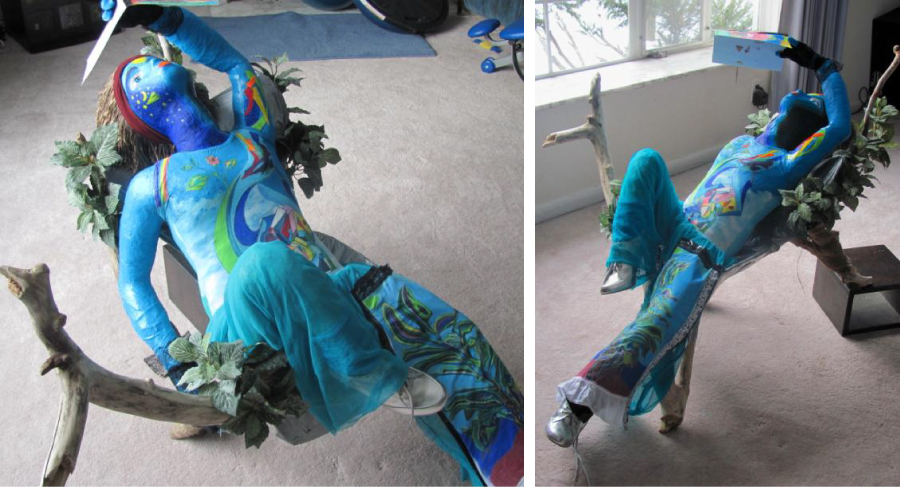
Artist: Sandra Holloway
The mannequin (Named “Mannie-me”) is a “concrete” representation of all that was once lost, now brought out “into the sun”. “Mannie-me’s” bold shapes and bright colors show the strength of her resilience and life-force. The tree symbolizes life, and her artistic dance outfit portrays another strength; her playfulness.
“Manne-me” languishes in a tree, reading. The back of her book reads:
The journey to healing is long and hard
But with what other journey
Do you reach into the darkness of shattered hearts
and return with golden sunlight, earth’s riches, and a spectrum of feelings.
Artist Profile:
Sandra Holloway has a PhD and currently teaches Psychology classes at a local University in the Philadelphia area of PA. Her special interest is in children on the Autistic spectrum. Sandra Holloway was born in South Africa, where experiences made coping a high priority that forced creativity and passion deep within her. Through her art Sandra has re-discovered these hidden strengths.





